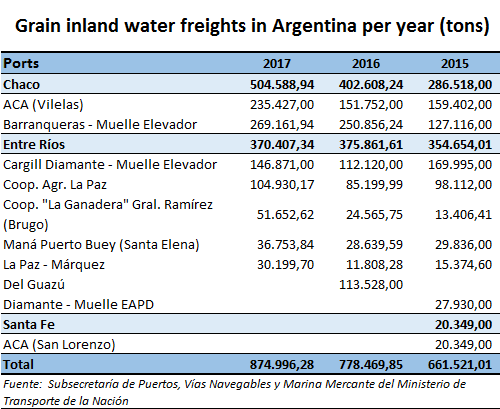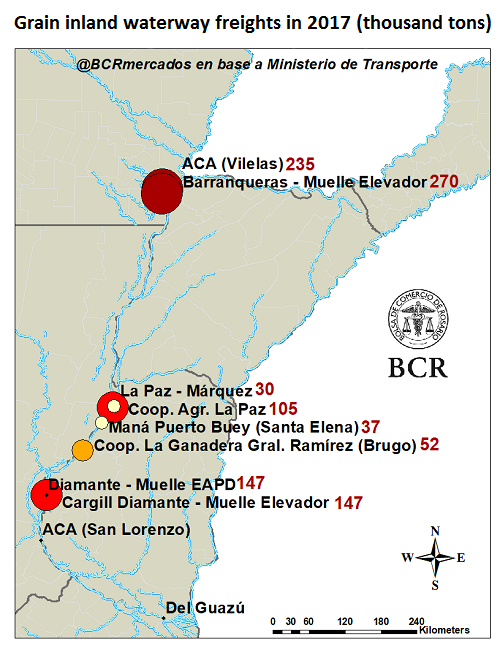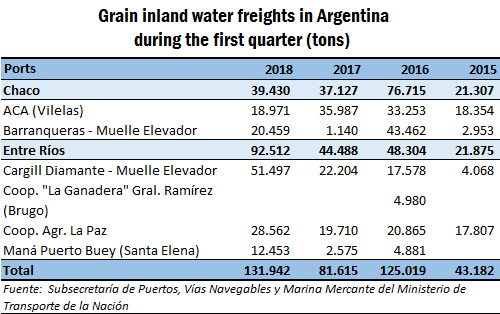Inland water freights in Argentina increased by 32% in two years
JULIO CALZADA - SOFÍA CORINA - ALFREDO SESÉ - EMILCE TERRÉ
The competitiveness of local agricultural sector strongly depends on the country's inland transport networks; therefore, it is crucial to study the Paraná-Paraguay rivers system. This waterway system, that is Argentina's most important commercial waterway, connects ports in the northern province of Chaco and the central province of Entre Ríos with the southern ports at the Rosario Hub (Santa Fe province). Over almost 25 years, Rosario Board of Trade's experts Rogelio Pontón, Héctor Di Benedetti and Luis Palermo, emphasized the importance of developing Paraguay-Paraná rivers system. While promoting this strategic vision, they highlighted the advantages of water freights over trucks and rail transportation. Low investment and maintenance costs, low energy consumption and less environmental impact are among its most important assets. Moreover, although water freight cannot compete with other means of transport for short distance or perishable products freights, it is ideal for long distance heavy loads transportation such as grain, iron ore and fuels. The cost of transporting a ton of soybean by truck, determined by a ton/kilometer ratio, is twice the cost of rail transport, while the waterway cost (t/km) is estimated at half the rail transport cost. There is great potential for Argentina to promote, develop and expand Paraná-Paraguay waterways system in the future. Based on data provided by the Under-Secretariat of Ports, Waterways and Merchant Marine (Ministry of Transportation) it can be inferred that there has been a sustained growth in the volume of inland waterway grain transportation to the posts at the Rosario Hub.
In 2017, inland grain water freights reached the 875 thousand tons, a year-on-year growth of 12.4%. The freights include soybean, corn and wheat cargos. When comparing 2017's transported volume with 2015's grain cargos, they are a 32.3% higher, approximately a third more. The ports located in Chaco province (Barranqueras and Vilelas) originate 58% of the total Paraná-Paraguay rivers system's freights, and these ports are the ones leading the growth of water commerce. Barranqueras Port is the most important port of the province; it ships about 270 thousand tons towards the ports in the Rosario Hub, representing a 31% of the total. The growth of Barranqueras' shipments was the main driver for the total volume increase. In 2017, this port originated 142 thousand tons more than in 2015, which implies a 112% growth.
Vilelas Port, managed by the Association of Argentine Cooperatives (ACA), is the second most important port in the province of Chaco. The port originates over 235 thousand tons, which represent a 27% of the total, and is 47.7% higher than 2015's shipments. Entre Rios province's major ports are Cargill Elevator Dock and Cooperativa Agrícola de la La Paz, both located in the city of Diamante. Both ports shipments exceed the 100 thousand tons, but they have not experienced the rapid growth observed in the province of Chaco's ports (Barranqueras and Vilelas). In contrast to this, the ports of Burgo (Cooperativa "La Ganadera" Gral. Ramírez) and La Paz (Márquez) showed a more significant growth, although on a smaller scale. Burgo Port shipped 13 thousand tons in 2015 and more than 51 thousand during the past year, representing a 285% increase. La Paz Port (Marquez) almost doubled the tonnage of grain originated between 2015 and 2017. Inland water freights prospects for 2018 The data from the first quarter of 2018 shows a favorable evolution of the number of inland grain water freights. Ports located in Chaco and Entre Rios originated 132 thousand tons, a year-on-year increase of 62% and a 205% increase if compared with 2015's shipments during the first quarter.
Given the seasonal differences among regions, the ports located in Entre Ríos have the greatest weight –and have experienced the sharpest growth- during the first quarter. In 2018, 92.5 thousand tons of grain were shipped from the Entre Ríos ports in the first quarter, more than doubling 2017's volume for the same period. While if compared with the first quarter in 2015, the freights increased by 323%. It is expected for inland water freights in Argentina to continue to grow in the future. Especially considering the fact that even when the crop was widely affected by the draught –leading to a drop in production- there has been a great year-on-year increase in terms of grain water freights so far.


